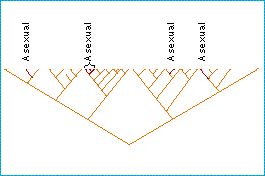Adaptations in sexual reproduction - Why do organisms reproduce sexually?

Lower extinction rates
It has been known since a paper by Weismann in 1886 that asexual reproduction has a peculiar taxonomic distribution. It is usually confined to an odd species, or perhaps a whole genus, within a larger taxonomic group that mainly reproduces sexually; only very rarely is it found throughout a larger phylogenetic group.
The spindly taxonomic distribution of asexual reproduction suggests that asexual lineages have a higher extinction rate than sexual lineages - that asexual lineages usually do not last long enough to diversify into a genus or higher taxonomic level.
Figure: the taxonomic distribution of asexual reproduction is spindly; it is found in odd, isolated taxa.
| Next |



